Still the best guide on the net!
Deep Fried Turkey
by Belly Buddy David Lauterbach
How many times have you sliced into a tasteless, bone-dry turkey on Thanksgiving wishing your fowl had not run afoul in the oven? This year, try frying your bird instead.
 Why fry? There is no other way I can think of to cook that will give you a moist, delicious turkey in such a short period of time. The skin will be crispy and the meat will be juicy and--depending on how you marinade it--spicy.
Why fry? There is no other way I can think of to cook that will give you a moist, delicious turkey in such a short period of time. The skin will be crispy and the meat will be juicy and--depending on how you marinade it--spicy.Deep frying a turkey is not a horribly difficult thing to do, but it requires some preparation and effort to do it right, especially the first time.
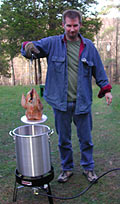 |
| The author with the bird of choice for today. |
There are plenty of variations from this recipe that can be done, and if you know what you're doing then by all means go ahead and variate. But if you've never done this before then pay attention, I'd hate to hear that you had deep fried arm for dinner.
A word of caution right from the start- this whole process must be done outside. Keep in mind that you will be working with bubbling, spitting oil heated to
Don't just take our word for it:
Consumer Reports has issued a caution on turkey fryers stating that Underwriters Laboratories (UL) has refused to certify any turkey fryer as safe! UL said all of six cookers examined could overheat oil to the point of combustion and goes on to use words like "scalding," "flames." "engulfed" and "fire." Don't say we didn't warn you to do this outside. For more info, check out Consumer Reports.
Aside from the regular ingredient list, first time fryer's are going to need the right utensils. Only a few years ago, I would have told you to start with a big pot and a wire hangar and scrounge up the rest of what you'll be needing. But today there are quite a few companies that make all-in-one kits. A basic kit includes a large pot, turkey stand, lift hook & fry thermometer. Spend a little more and get one that includes an injector and a burner if you don't already own one. The addition of a smaller fry pot and a basket will turn that one-hit kit into a frying multitasker. Make sure the pot is at least a 26qt- you can get a 30qt. or more, but consider this...you'll have more room to breathe, but if you're going to only be cooking 10 pound birds, that larger pot will just waste oil.
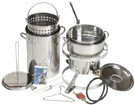 Eastman Outdoors is one of the companies that we highly recommend and they are readily available through the Brian's Belly Eastman/Amazon store (extensively).
Eastman Outdoors is one of the companies that we highly recommend and they are readily available through the Brian's Belly Eastman/Amazon store (extensively).Eastman makes many kits with aluminum and stainless steel pots. If you are one of those people that likes shiny new toys, go for the stainless steel 30-quart professional kit. If stainless is a little too costly, try one of Eastman's aluminum combos.
Then there is Bayou Classic who makes a several size kits- a 28qt., a 30qt. and a 34qt. aluminum pot kit- the burner can be cranked up to 185,000 BTU’s. It has a 14" wide welded steel frame (that is quite rugged) and a turkey stand & hook. The only thing we don't like about this kit is the plastic injector. The Bayou Classic brand is sold nationally at Home Depot and can be found for as low as $69- conveniently, Home Depot also sells peanut oil for around $19 for 2.3 gallons.
Chef William's (of QVC fame) may or may not still sell kits, but it's just as well. The original fryer we had for review was poorly made and used a basket to fry the turkey instead of a stand. But his Cajun Injector is still available, and is still the best injector you can buy.
Other brands we don't know too much about are King Kooker which we've seen at Dick's Sporting Goods & Sam's Club and Morrone which we've seen at Lowe's.
Overall, our recommendation would be the Eastman or Bayou Classic brands for a kit and then stop by Chef Williams site to pick up a gift marinade pack (that comes with an injector).
As we mentioned in eye-catching italics above, at this time NO turkey fry kits are UL listed, however Eastman now has a burner that is CSA-approved... Canadians rejoice!
Before creating an actual ingredient list, let me tell you a bit about why you're going to need the things on the list.
A 15 pound turkey is about the maximum size bird you want to cook like this. Aside from being unwieldy, larger birds need to cook much longer. Your Birdzilla would take over an hour and most likely the skin would be overcooked.
An injector is used to infuse the bird with liquid seasoning. When the oil sears the skin of the turkey on contact, the natural juices and the marinade are sealed in- meanwhile, the oil is sealed out. I'll explain how to do this later on when we inject the bird. The dry seasoning is used as a dry rub on the skin of the turkey (and inside if you'd like). I love Tony Chachere's Original Creole Seasoning (the one in the green shaker) so that's what we're going to use. If you don't have this, or want to substitute your own favorite brand, go right ahead. Belly Buddy Scott Stout uses nothing but Zatarain's and insists on adding bourbon to the marinade.
The oil you use is up to you but most prefer peanut oil for this type of cooking. It is healthier, tastes great and has a very high flash point- meaning that it is the least likely to smoke or flame up and start a fire. It's also the "cajun" way to do this.
You should also have meat and fry thermometers on hand.
(continued below)
So to recap, here's what you're going to need:
- One 10-15 pound turkey
- 4-5 gallons of peanut oil
- 8-16 ounces of liquid seasoning (marinade)
- Tony Chachere's Creole Seasoning
- 26 quart (at least) pot
- Burner & propane tank
- Oil thermometer
- Meat thermometer
- Turkey stand
- Lengthy hook
- Oven mitts, or the considerably more manly asbestos gloves
The marinade is up to you- you can season to taste. If you have a favorite that you have used with fowl, or you like to create your own, then give it a try. I've frequently used Tabasco® brand Garlic Marinade (it's been my personal experience that if it says Tabasco® on the bottle that I will like it). If you have a favorite, let us know about it and we'll post it here. Dick's Sporting Goods is a good place to find Eastman as well as Tony Chachere's injectable marinades (their garlic and butter marinade is very popular, and very traditional).
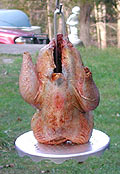 |
| This wild turkey was shot and prepared by Uncle Belly Buddy Ken Lauterbach. |
Prep the turkey. Make sure that the bird is completely defrosted. Remove the junk from the cavity of the bird and any plastic pop-up device- it won't work here. Load the injector with your marinade. Carefully lift the skin from the meat and insert the needle into the meat rather than puncturing the skin. This keeps the marinade and natural juices from leaking from the turkey when you fry it. Do this in several locations, including the breast, thigh and drumstick. Inject the breast in several different directions in several different locations. The more you use, the more flavorful the meat will be.
Try to do this the night before you plan on cooking the bird. This way it has several hours to marinate. The injection process definitely shortens the amount of time needed, so if you can't do it the night before then a few hours before will have to do.
Using the dry seasoning, rub the bird all over. I hope this doesn't turn you on. Rubbing and massaging the bird will help the marinade to mingle with the meat.
When you are ready to get cooking, put the oil into the pot and fire up the burner. It will take you somewhere around 20 minutes to get the oil to
 |
| If you don't monitor this simple to understand gauge, the temperature can easily reach over |
Make sure that the bird is dry. Water and oil do not mix very well- this would be pretty obvious if you threw an ice cube in the pot, but don't do that. Instead, towel off the bird if you have to. Hold it up and make sure no water is in the chest cavity.
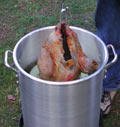 Place the bird on the turkey stand drumsticks up and head down (well, if he still had a head) and pull his arms back behind his shoulders if possible. When the oil has reached
Place the bird on the turkey stand drumsticks up and head down (well, if he still had a head) and pull his arms back behind his shoulders if possible. When the oil has reached  The oil temperature will drop because you are putting a cold--or preferably room temperature--bird into the pot. There are all kinds of scientific thermal transfer issues going on here that only Alton Brown could understand, but all we need to know is that something hot plus something cold equals something warm. Raise the burner a bit to get the temperature back up but don't put the lid on in an attempt to speed this up- the oil will get way too hot. As mentioned earlier, a dangerous situation can occur when the oil gets too hot...
The oil temperature will drop because you are putting a cold--or preferably room temperature--bird into the pot. There are all kinds of scientific thermal transfer issues going on here that only Alton Brown could understand, but all we need to know is that something hot plus something cold equals something warm. Raise the burner a bit to get the temperature back up but don't put the lid on in an attempt to speed this up- the oil will get way too hot. As mentioned earlier, a dangerous situation can occur when the oil gets too hot... The cooking time varies and depends on the size of the bird. Since this is Brian's Belly, we'll put it in a table for you. This is assuming
| Temperature | ||
| Weight | Minutes Per Pound | Total Time |
| 10 pounds | 3 | 30 minutes |
| 11 pounds | 3 | 33 minutes |
| 12 pounds | 3 | 36 minutes |
| 13 pounds | 3 1/2 | 45:30 minutes |
| 14 pounds | 3 1/2 | 49 minutes |
| 15 pounds | 3 1/2 | 52:30 minutes |
As we then say in all of our Brian's Belly recipes... now would be a good time to grab a beer.
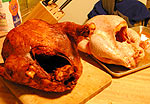 When time is up, don your mitts and using the hook, carefully lift the bird from the pot. Holding it over the oil, let it drip a while. Insert the meat thermometer into the breast. The temperature should be around 165° fahrenheit. If it's not, you may have to put it back it for a few more minutes- do not remove it too early or eat it undercooked.
When time is up, don your mitts and using the hook, carefully lift the bird from the pot. Holding it over the oil, let it drip a while. Insert the meat thermometer into the breast. The temperature should be around 165° fahrenheit. If it's not, you may have to put it back it for a few more minutes- do not remove it too early or eat it undercooked.Place it on a cutting board and cover it with aluminum foil for 20 minutes or so. The bird will continue to cook, even while sitting on your kitchen counter and will reach the optimal 170° that is recommended by the U.S. Dept. of Agriculture.
Since you are done frying, turn the burner off and remove the pot from the fry stand to a firm, level, heat-resilient surface out of harms way--five gallons of 350° oil can be deadly to dogs, small children and even careless (read: drunk) adults.
When you're ready, carve it up (watch for squirting juices) and serve it up (watch for smiling faces).
When all is done, there is no reason to dump those five gallons (and about $40) worth of oil right back into the environment. Peanut oil is a high quality oil that can withstand several fry cycles. After the oil has cooled and the junk has settled (perhaps overnight) you can filter the oil and pump it back into the plastic container it came in. Stored in a cool, dry place, peanut oil should not spoil and will remain useable for six months. If you "smoked" the oil by accident, you'll have to toss it. We feel obliged to tell you to check with your local regulations on proper disposal, but most of the time oil must be accepted at your neighborhood auto-mechanic shop.
I hope after you try your turkey this way, you will never go back to the oven. Bird appétit.
Get ready to practice shooting gobblers and jakes for turkey hunting season. Check out Turkey Shoot. Remember... aim for the head!
Belly Buddy Scott Stout came through for us with a recipe for Hush Puppies that will go great with your Deep Fried Turkey.
And Belly Buddy Fatty Matty has sent us the mix for a proper Turkey Rub for your bird.
No comments:
Post a Comment